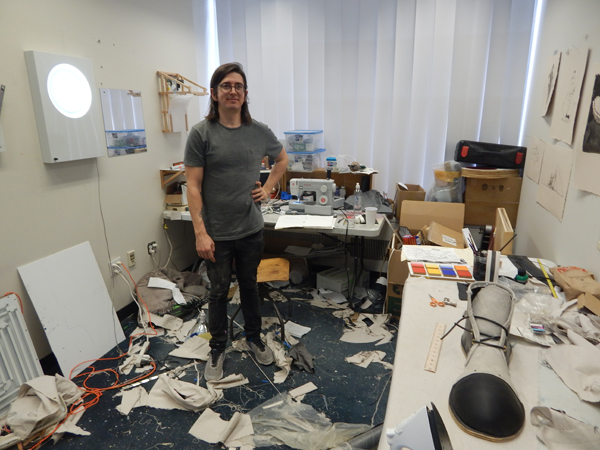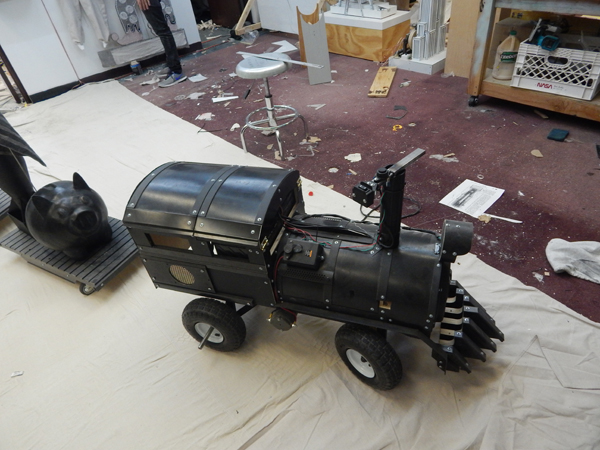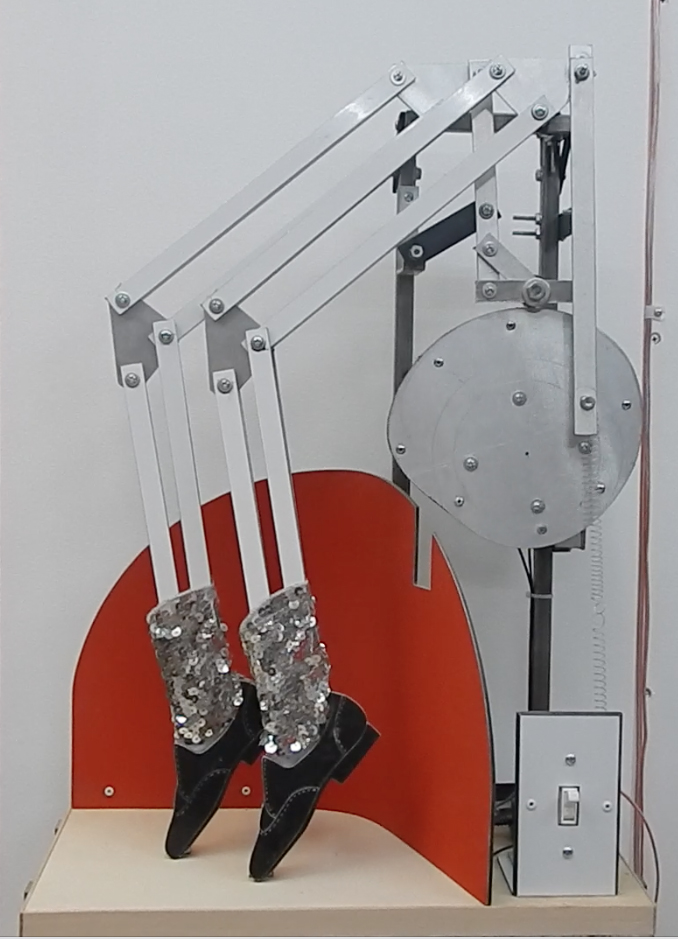
Artist Nick Doyle makes full use of the free studio space he enjoys through the Lower Manhattan Cultural Council’s residency program at 28 Liberty St.
BY DENNIS LYNCH
On the 24th floor of 28 Liberty Plaza, Nick Doyle is cutting plywood with a bandsaw. But he’s not a contractor building out offices for one of the financial-service tenants in the building — he’s an artist, and tenant himself.
Doyle is one of about 30 artists taking part in a 9-month residency program at 28 Liberty run by the Lower Manhattan Cultural Council. The residency gives artists free studio space to ply their varied crafts, be it film, painting, dance — or in Doyle’s case, mixed-media, kinetic sculptures.
The program, sponsored by 28 Liberty owner Fosun, provides a one-time $1,100 stipend to help with materials, moving in, and other costs. Each artist gets 150–300 square feet of basic space and some storage. They also hold weekly meetings that can include one-on-one studio visits, workshops, lectures, and even potluck dinners.
The surreal space is unlike any other art studio in the city — an entire 35,000 square-foot floor in one of the priciest office towers in Lower Manhattan, but instead of cubicles it’s filled with paintings, Apple computers, and sawdust. The oddness is not lost on Doyle.
“I ride the elevator with people in suits and I’m covered in s***,” he said. “It really puts you in a place with people you wouldn’t necessarily spend your days in.”

Doyle’s current project, a battery powered train he calls “American Express,” trails symbols of “leftover practices of American culture” — such as a piggy bank representing the financial system.
Doyle has turned one of his office spaces into a woodshop and another into a general workspace, where he’s currently working on a small, battery powered train he calls “American Express.”
The knee-high train is adorned with symbols of “leftover practices of American culture,” including an oversized Cleveland Indians logo, a nuclear bomb, an oil well, and a piggy bank representing the American financial system.
Doyle parked American Express outside his office space, where he’s also hung some his moving, kinetic sculptures — mesmerizing mazes of electrically powered levers and joints that, say, slyly slide a pair of ace playing cards in and out of “sleeves,” or lift spangle-socked feet to dance like a certain King of Pop.

The King of Pop can dance on forever in the studio of kinetic artist Nick Doyle.
Doyle is thrilled to have the free space. He’s been involved with the program since 2012 and says it has saved him thousands of dollars he would normally pay for studio rent. Prices for art-studio space are rising right along with rent for living space, he said.
“Something that’s been happening recently with real estate is that people are realizing they can charge just as much for studio rent as they can for people’s homes, so everything is three or four dollars a square foot,” Doyle said. “Artists are generally poor, most of the time, so access to free space is pretty valuable.”
Around 1,200 applicants put in for spaces in the program this year, according to LMCC’s vice president of cultural programs, Melissa Levin. There’s good reason — the space is open 24 hours a day, so artists can work on whatever they want, and they don’t even have to finish any project by the end of the program.
“The philosophy is really about putting as few restrictions as possible on what kind of work is being made, what hours the artists are using,” Levin said. “The program is really committed to further developing their creative practice in the studio.”
LMCC puts together juries of discipline-specific professionals to whittle down the list of applicants based on their past work and what they have planned for the future. The finalists are interviewed and asked, more or less, “Why you, why LMCC, why now?”
LMCC was founded in 1973, and from 1997 to 2001 its artist residency program was based in the World Trade Center’s North Tower. Since the 9/11 attacks, they’ve held residences around lower Manhattan, including at 1 Liberty Plaza, 315 Hudson St. and the Woolworth Building.
“We have managed to find very willing and enthusiastic partners, especially in the real estate community,” Levin said. “We work with local real estate owners and minimally adapt and take over these temporarily vacant commercial spaces and adopt them for artist use.”
Because affordable studio space is so hard to find, Downtown hasn’t been the most attractive neighborhood for artists, nor the most artistically vibrant, despite its rich architectural and historical heritage. That’s not for lack of desire though. Doyle called it his “favorite part of the city,” and would live here if he had the option. But unless real estate prices go down, which doesn’t appear imminent, Doyle will have to keep hauling his works to galleries outside the ‘hood for exhibits.
“The Lower East Side is where a lot of the scene is — Chelsea and the LES — there’s been a few spaces down here, but I think it has to do with the availability of space, and the real estate down here is just astronomical compared to even just a little bit uptown,” he said.
The artist residency at 28 Liberty is one of a half dozen LMCC runs in Lower Manhattan, and is one of the largest and most robust, along with their residency on Governors Island. Together, LMCC hosts 100 artists in the residencies, and runs about 60 free public events annually, including the River To River Festival.
This year LMCC will hand out $651,000 in grants for 150 projects around Manhattan. About half of the funding will go to individual artists and artist collaborations, and the other half to arts organizations. LMCC also offers artist development programs, which include seminars and workshops to help artists square their finances as their careers progress.

















